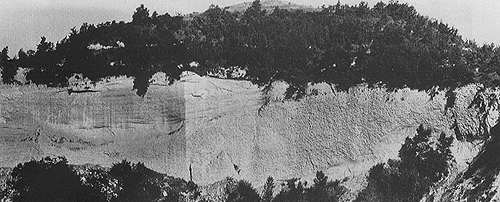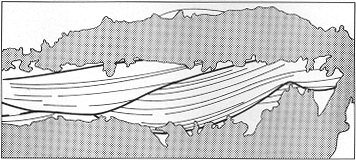

Paleoslides: detachment scars
Plate 138


Paleoslides: detachment scars
Plate 138
Subaerial and subaqueous slides have similar morphologies, in which three parts are distinguished: the zone of detachment, where a morphological scar is left by the moving away mass, the zone of translation, or slippage, and the zone of accumulation. The intermediate zone can be short and virtually coincide with the last one. Extensional stresses dominate behind the detaching mass, compressional ones in front of it (see drawing in plate 131). The examples of slide deformation we have seen in previous illustrations concern, with the exception of the upslope portion seen in plate 130 A, the accumulation zone. To conclude this section, I examine now one of the few published examples of possible slide scars in the fossil record. 4
Curiously enough, the outcrop is itself a Recent slide scar; in other words, Recent slides have made possible to observe an older (Miocene) analog. The geometry of the section is similar to a kind of giant trough cross-bedding, or to the fill of stacked, partially shifting channels. What does not fit with these interpretations, however, is the fact that sediments are not coarse-grained; thereby, they do not represent deposits of high-energy flows. Neither are lag pavements present to signal possible bypass zones of channels. The rock is a thin-bedded, hemipelagic marlstone, where bedding has partly been obliterated by the activity of benthic organisms (bioturbation). A modest to moderate paleodepth can be inferred from the fauna.
It is thus reasonable to assume that the "erosional" surfaces are scars left by slides on the upper part of a paleoslope; the removed masses should be found in a deeper and more distal part of the basin (accumulation zones are recognized by an anomalous thickness of sediments, even if the slides themselves are not visible).
The strata filling and draping the scars make onlap contacts with them.
S.Agata Fossili Formation, Tertiary Piedmont Basin, Italy.
Note 4: P. Clari and G. Ghibaudo. 1979. Multiple slump scars in the Tortonian-type area (Piedmont Basin, northwestern Italy). Sedimentology 36: 719-730. Back.